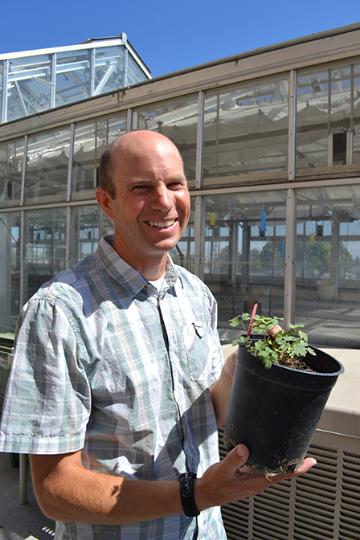
Flower Power
During summer 2015 associate professor of biology Justen Whittall worked with Jose Carlos del Valle, a Ph.D. student from Universidad Pablo de Olavide (UPO), in Sevilla, Spain, as part of Whittall’s continued collaboration with UPO on research linked to flower color evolution in response to changes in climate. While the subject may only catch the eye of a reader with very specialized interests, it is fertile ground for Whittall’s students, some of whom have already developed technologies that are generating revolutionary insights across the biological sciences.
Take Timothy Butler ’10, who joined Whittall and UPO’s Dr. Eduardo Narbona on a trip to the North Slope of Alaska as a research assistant. Together they observed that the white mustard flower, one that is typical to the region, became rarer and was replaced by the pink form as they continued to travel north into the Arctic Circle, where the climate becomes increasingly stressful.
Upon their return to Santa Clara, Butler, a Biology major, dedicated himself to the mind-boggling task of finding a unique gene -- the one responsible for color adaptation -- among over fifteen thousand to add credence to the team’s hypothesis. As part of his research he developed a groundbreaking bioinformatics pipeline, or a series of steps codified in computer scripts to reassemble huge amounts of genomic data, taken apart originally in search of the targeted gene -- work that earned him the prestigious DeNardo Senior Prize in 2010. Alumna Cynthia A. Dick ’08, and fellow Biology major, utilized her expertise in molecular biology to validate Butler’s techniques, and together they published their results in the online science journal PLOS ONE. To date, their paper has been viewed nearly 4,156 times and downloaded nearly 900 times, and has attracted the attention of teams from as far as China and Australia, working on similar flower color research.
For Whittall, who splits his time among field work, the SCU greenhouse, and his lab on the second floor of the Alumni Science building, his collaborative projects are an investment that pays off in the classroom “An idea has been percolating in my head over the summer,” he says as he prepares to teach an upper division class in evolutionary biology in the fall. He’ll dispense with the typical cookbook experiments for the laboratory. Instead, he’ll have his students extract plant DNA by the end of the second week. “I will then ask an evolution question and let science happen. I like to throw out big questions and let students rise to the occasion. Some prefer to shoot low. We at Santa Clara prefer to shoot high. Our students can handle it.”
His students will be using some of the same techniques developed by Butler and Dick before them – techniques that are as useful in the study of flower colors as they are in the search for genes related to rare cancers and inherited diseases. Some will follow in Dick’s footsteps who, having worked in Whittall’s lab for several years as a technician, went on to UC Riverside to study tropical guppy color patterns in the rivers of Trinidad; others will follow in Butler’s, who is currently a Ph.D. candidate at Oregon Health Science Institute in Portland in their genomics & bioinformatics group using Next-Generation sequencing technologies--similar genomic approaches he learned and developed in Whittall’s lab-- to understand human stem cell genetics, development, and applications in cancer research. But regardless of their path, they will be able to point to the lab on the second floor of Alumni Science, where shooting high is taught by example.